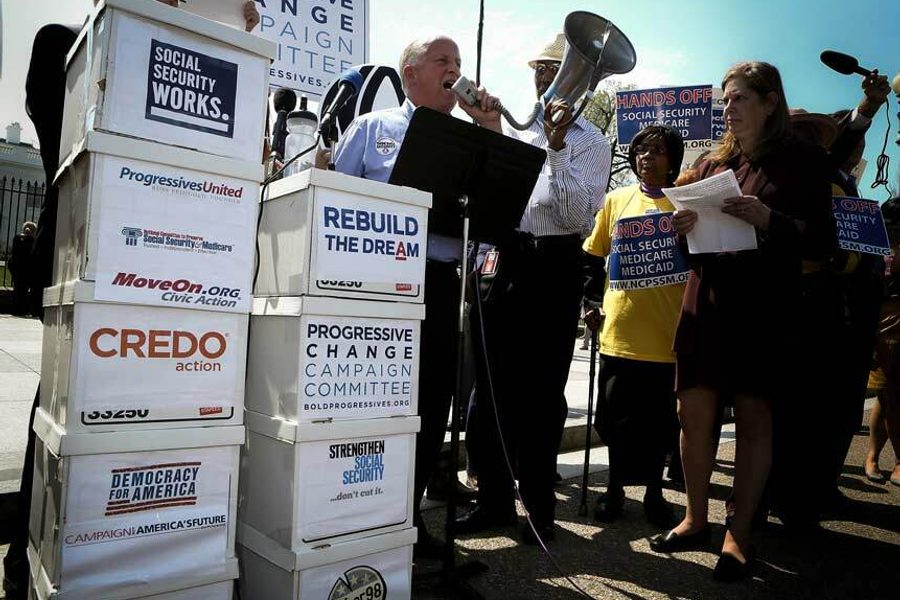How Social Security Was Saved
Progressive groups and their allies in Congress win one for the people.
Cole Stangler

The release of the White House’s 2014 budget in April 2013 was a stomach-churning occasion for American seniors who depend on Social Security.
In an effort to woo the austerity-now crowd, President Barack Obama included in his proposal a new formula to calculate Social Security cost-of-living adjustments: the chained consumer price index, or chained CPI. Presented as a harmless technocratic fix, chained CPI would have hit America’s retirees in the pocketbook by reducing their Social Security cost-of-living increases.
At the time, much of Washington was fixated on the “grand bargain”—a long-term bipartisan budget deal. To centrist Democrats, chained CPI seemed like the ideal bargaining chip to nudge Republicans into accepting modest tax increases on the wealthy.
This year, Obama’s 2015 budget includes no mention of chained CPI—a victory that can be attributed to progressive organizers working inside and outside the halls of Congress.
Chained CPI reared its head in Congress in late 2012, when the Republican and Democratic leadership were trying to broker a deal to avert the so-called “fiscal cliff ”—automatic across-the-board spending cuts. The president had previously floated chained CPI in the summer of 2011 as a way to incentivize a long-term budget compromise, and now he was doing it again.
D.C. progressives were unnerved to find so many Capitol Hill Democrats receptive to the use of Social Security as a bargaining chip. Alex Lawson is executive director of Social Security Works, a group that seeks to expand Socia Security. “If you went around the Hill,” he says, “the Democrats were willfully silent, getting messages from the White House that we have to do [chained CPI]. People didn’t know if they were allowed to fight against it.”
Lawson was also disturbed by the disconnect between the attitudes of policymakers and the will of the people. Polls from the last few years consistently show that a majority of Americans are opposed to Social Security cuts.
While groups such as Progressive Democrats of America (PDA) and Social Security Works, in addition to the AFL-CIO and AARP, had been raising the alarm about cuts since the Bowles-Simpson Commission in 2010, Lawson felt the threat demanded a larger, more active coalition. So he teamed with progressive organizers from CREDO Action and Netroots Nation to help translate public opposition into stronger Congressional opposition. They put out a call for an informal meeting about chained CPI. The goal was to get a broad swath of the national progressive movement to take a stand against cuts.
That may seem like a no-brainer. But fresh in Lawson’s and others’ minds was the healthcare-reform debacle. A coalition that had been united in support of the public option gradually buckled under pressure from the White House and Democratic leadership, eventually settling for a version of the Affordable Care Act that lacked a public option and that no one liked much.
“Progressive groups … all started off on the same page, but throughout the course of this fight, [power brokers] on the Democratic side would be able to pull people off on certain issues,” says Netroots Nation’s Raven Brooks of the healthcare compromise.“There are a lot of reasons why [a public option] didn’t win as a policy option, but … an important piece of it was this destruction of the unity that was there initially.”
During the 2012 fiscal-cliff showdown, Brooks and others were determined to stop history from repeating. So, in December 2012, about 35 representatives of progressive groups—the AFL-CIO, the Progressive Change Campaign Committee (PCCC), Democracy for America, MoveOn and Progressives United, among others— came together and held a thumbs-up and thumbs-down vote on whether to draw a line in the sand against any cuts to Social Security, Medicare and Medicaid. The result was unanimous: Chained CPI was an unacceptable pill to swallow, no matter the circumstances.
Congress didn’t reach a grand bargain in time to avoid sequestration. The budget cuts took effect in March. But with the White House still committed to striking a long-term compromise with the GOP, progressives kept up the pressure to save Social Security.
Led by Social Security Works, PDA and the PCCC, the coalition kicked off the New Year by pressuring the Congressional Left to go on record against chained CPI. In the Senate, they lined up Bernie Sanders (I-Vt.), Tom Harkin (D-Iowa) and Elizabeth Warren (D-Mass.), who all spoke out against the proposal. In the House, the coalition found a champion in Rep. Alan Grayson (D-Fla.), who had just retaken his seat after a defeat in the 2010 midterms.
Grayson and his colleague in the Progressive Caucus Rep. Mark Takano (D-Calif.) rallied House Democrats against chained CPI by rounding up signatories to a letter that drew a hard line against slashing the social safety net. “We will vote against any and every cut to Medicare, Medicaid or Social Security benefits,” the letter promised. Forty-four Congress members, including Progressive Caucus Co-Chairs Keith Ellison (D-Minn.) and Raúl Grijalva (D-Ariz.), signed the Grayson-Takano letter and six more representatives made statements in support of it. That effort triggered a less strongly worded anti-cuts letter from Rep. Jan Schakowsky (D-Ill.) that drew 107 signatures.
Meanwhile, in April 2013, the progressive coalition delivered a petition with more than 2 million signatures to the White House. And the AARP coordinated a large-scale petition drive against chained CPI, culminating in August 2013 with the delivery of 1.5 million signatures to the House Ways and Means Committee.
At that point, Grayson was confident the president’s proposal was dead in the water.“The combination of all these efforts on our part made it clear that the proposal was a political loser and would substantially undermine support for the president and anyone else who pursued it,” he says.
Tim Carpenter, national director of PDA, says the fight shows what the nationally focused progressive groups can accomplish when they devote their resources toward a common goal. “It wasn’t so much about branding your organization,” says Carpenter, “but [instead about] coming together around the issue and framing the issue as part of a larger progressive movement.”
Of course, it was only a minority of Democrats actively agitating against cuts. But the opposition was amplified by the fact that there was no countervailing Democratic congressional force. All of the enthusiasm for slashing benefits emanated from the White House. Neither the 53-member neoliberal New Democrat Coalition nor the 15-member conservative Blue Dog Coalition, for instance, served up pro- chained CPI letters. This suggests that the no-cuts camp wielded influence that went beyond its visible voting bloc.
Of course, it wasn’t just the work of organizers and left-wing members of Congress that kept chained CPI off the table. As the 113th Congress moved through its first session, Republicans had deluded themselves into thinking they’d be able to go on a budget-slash- ing binge without giving anything in return. As they repeatedly refused to give ground on tax reform, the GOP helped make the prospects of a deal unlikely.
The White House did not respond to In These Times’ request for comment about the impact of progressive opposition to chained CPI.
From defense to offense
But the progressive coalition wasn’t satisfied with holding the line. A few months into their defense of Social Security, progressive organizers, sick of playing defense, decided it was time to encourage its expansion.
In the summer of 2013, the same core of mostly online progressive organizers put out a call for another informal gathering, this time devoted to the question of expanding Social Security. The crowd gathered in late June at the Netroots Nation conference in San Jose. The vote was, once again, unanimous. “The idea was we don’t want to fight for just definitional stuff [like defending Social Security],” says Lawson. “Let’s fight for our aspirational stuff.”
The Netroots crew also reached a consensus on how to back an expansion. Initially, some wanted to back a proposal from Sen. Mark Begich (D-Alaska), a moderate facing a tough reelection fight in his conservative-leaning home state. Others favored liberal stalwart Sen. Harkin’s plan, which went a step further than Begich’s by creating a new formula for calculating benefits that would boost them, on average, by about $70 a month. In order to maintain unity, the groups decided to cross-endorse each bill, and together push for the “Harkin-Begich plan.”
A month later, the blitz was on.
On July 27, the senators went on The Ed Show on MSNBC to promote their proposal to scrap the program’s cap on high-income earners and increase benefits. Yearly income above $113,700 is exempted from the payroll tax that funds the Social Security Trust Fund. Lifting that cap would extend the program’s long-term solvency and provide the means to fund two major increases: Harkin’s proposal to raise monthly benefits and a more generous cost-of-living adjustment.
The PCCC sent out a video of the segment to its supporters, and along with Democracy for America, Social Security Works and CREDO, started collecting signatures in support of an expansion. They now have more than 650,000. The AFL-CIO, too, strongly backs Social Security expansion. Neither Harkin’s nor Begich’s bill stands a chance of passing the GOP-dominated House, but that’s beside the point— the Harkin-Begich plan, at its core, is about messaging. It’s about changing the parameters of the debate over Social Security, which during the Obama era has been limited to quibbles over how much to cut. By these measures, the drive for expansion has been a re- sounding success.
This offense-is-the-best-defense strategy probably helped push chained CPI and the grand bargain off the White House’s agenda. But the push for expansion bore other fruit. Instead of withering away like most “clicktivist” initiatives, the effort helped pave the way for what many call the “new populism” in Congress, buoyed by the headline-grab- bing abilities of Sen. Warren.
In November 2013, Warren spoke on the Senate floor, blasting chained CPI and backing Harkin and Begich. An ensuing kerfuffle revealed how drastically inner-party dynamics had shifted in the course of only a year. Writing in the opinion pages of the Wall Street Journal, the leaders of Third Way, a neoliberal think tank, charged that “economic populism is a dead end for Democrats.” The article generated backlash, which, in turn, sparked much public debate about the future of the party. About a month-and-a-half after the op-ed, Rep. Allyson Schwartz (D-Pa.), who’s running for Pennsylvania governor, resigned as honorary co-chair of Third Way. (Her spokesperson said the congresswoman thought the article was “outrageous and strongly disagree[d] with it.”)
Out to further prove her credentials to the Left, Schwartz went on to lead the effort to get Obama to ditch chained CPI in his recent budget. Instead of one of the usual suspects like Grayson, Takano or Grijalva, it was Schwartz’s name that appeared at the top of a February letter to the White House decrying the proposed cut, followed by 116 other members of Congress.
It is that kind of jockeying that provides evidence of where Democrats want to stand on Social Security ahead of the 2014 elections.
What began as a fundamentally defensive fight has now evolved into an offensive one. The PCCC is trying to make Social Security an election issue in 2014. Each of the four non-incumbent candidates the group has endorsed so far—Kelly Westlund in Wisconsin’s 7th, Lee Rogers in California’s 25th, Daylin Leach in Pennsylvania’s 13th, and Shenna Bellows, running for Senate in Maine—all support strengthening the program.
Westlund is taking on Rep. Sean Duffy, a Tea Party Republican (and lumberjack) who lauds “entitlement reform,” in a district with the highest percentage of seniors in the state.
“Social Security is one of the most effective anti-poverty programs that we’ve ever had,” Westlund says. “If we scrap the cap, that’s only going to expand the opportunity for seniors to stay out of poverty for the future.”
Toying with cost-of-living adjustments was supposed to be an easy way to reduce Social Security benefits. It just may have been the Left’s long sought-after impetus to expand them.
Cole Stangler writes about labor and the environment. His reporting has also appeared in The Nation, VICE, The New Republic and International Business Times. He lives in Paris, France. He can be reached at cole[at]inthesetimes.com. Follow him @colestangler.









